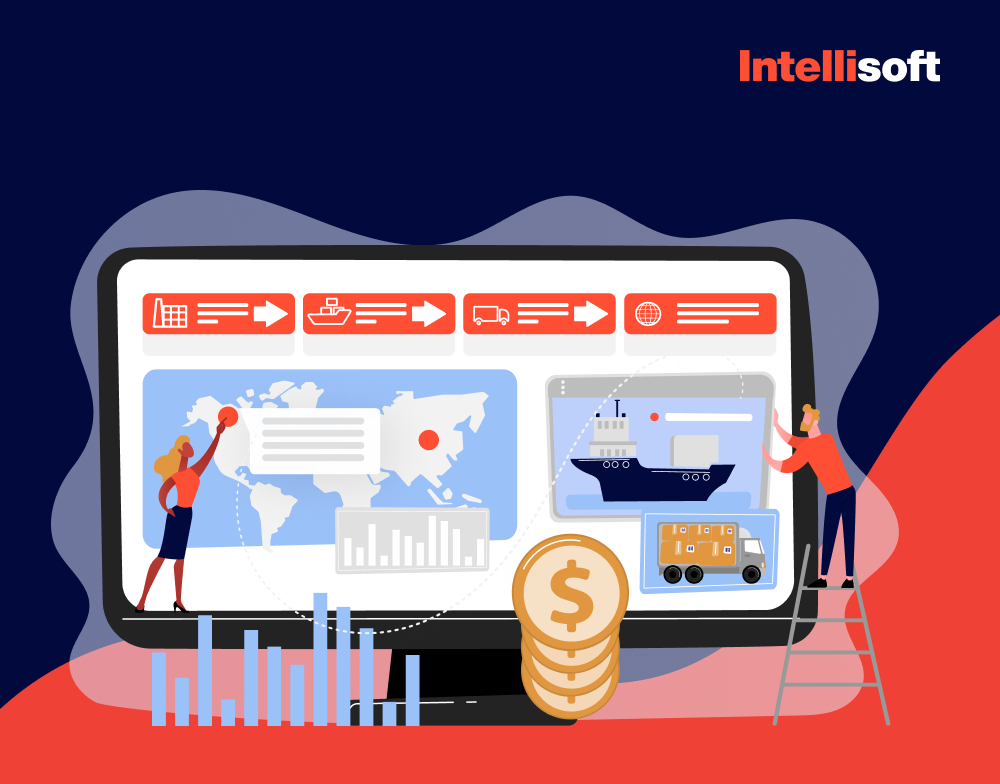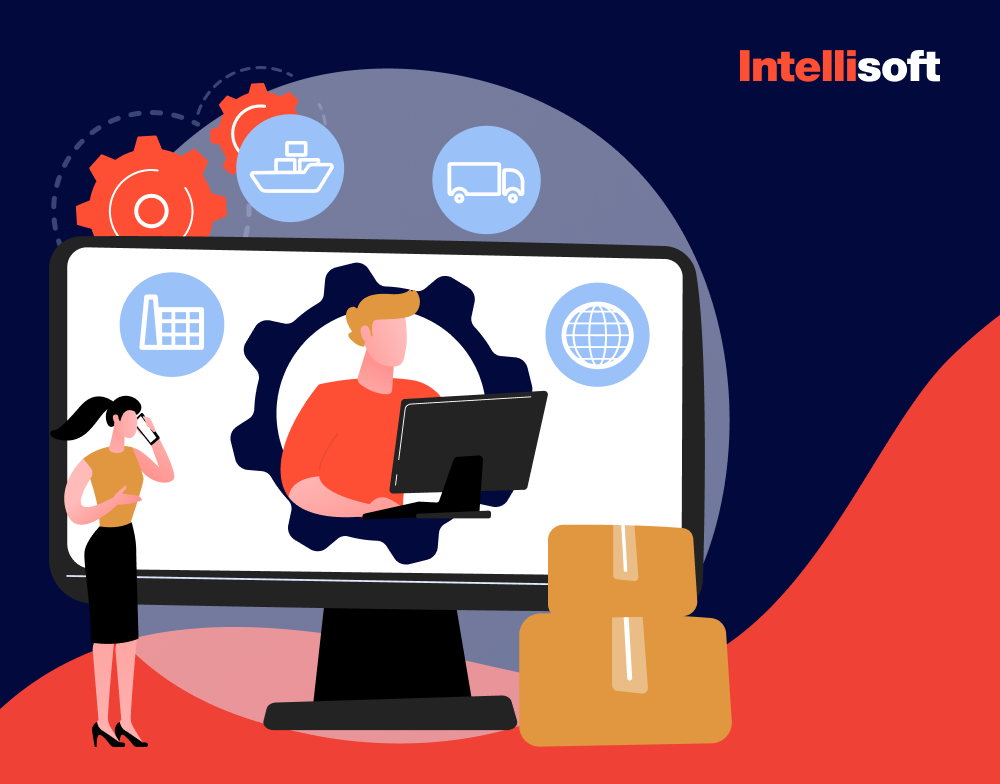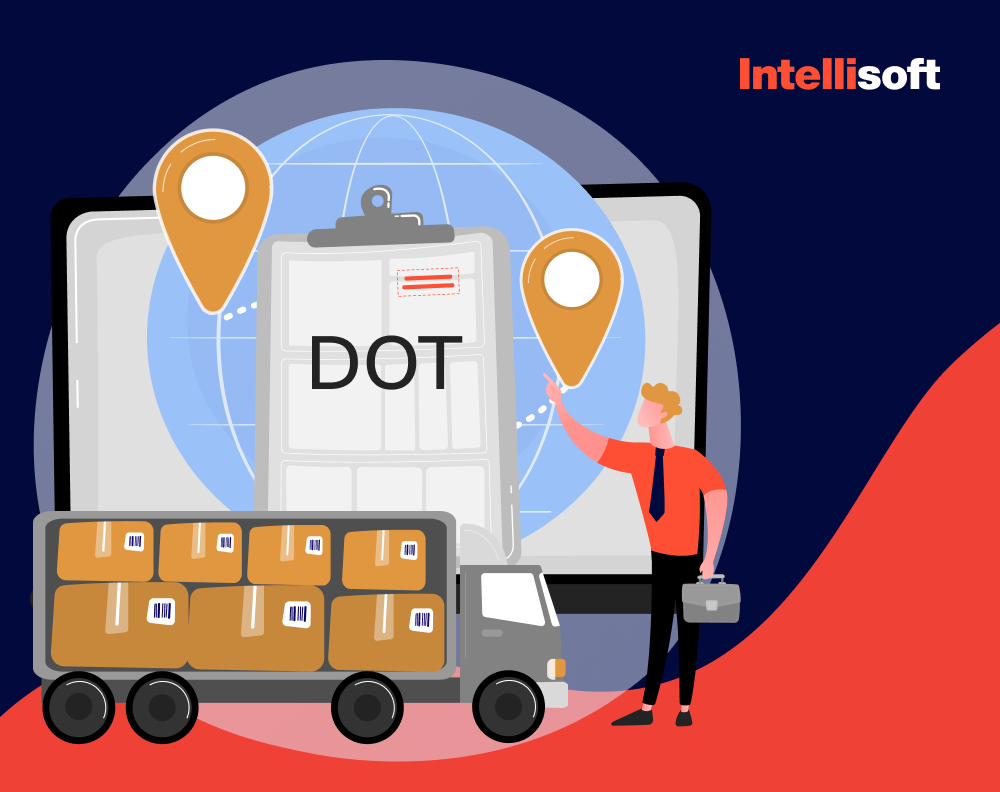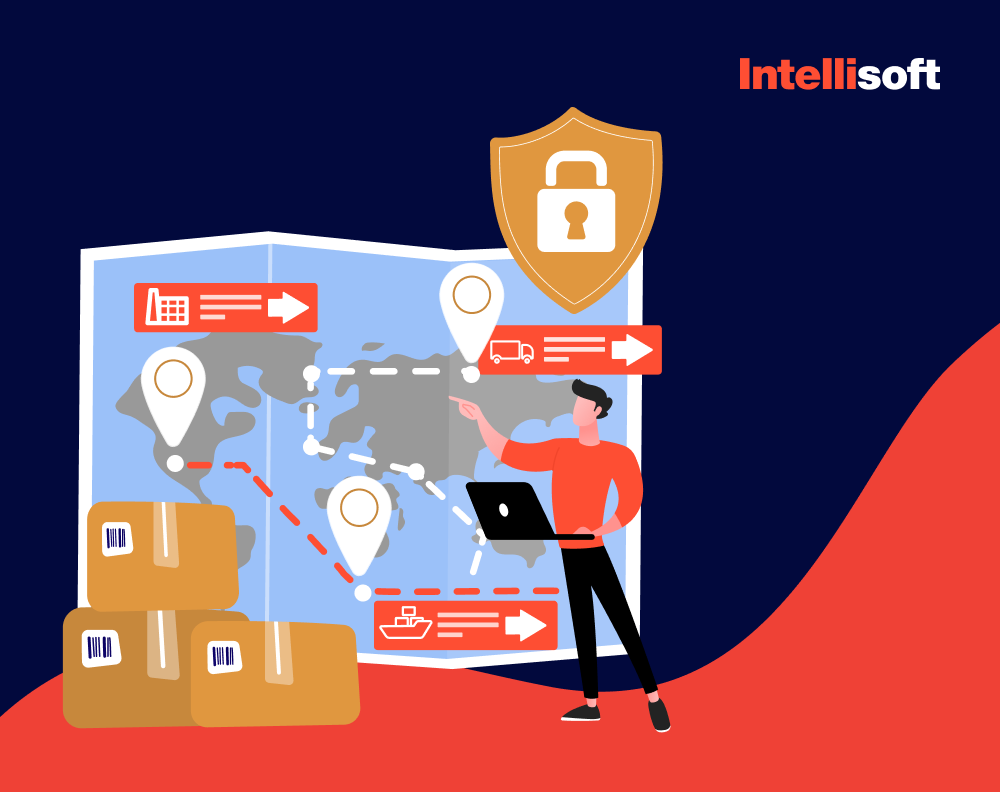Telematics refers to using GPS technology and onboard diagnostics (OBD) to monitor the location and movements of vehicles, machinery, and other assets. This system, often called fleet or GPS vehicle tracking, has become invaluable for the logistics domain. Let’s learn about the telematics system in a guide by IntelliSoft.
As David Coleman, Telematics Industry Expert, said, “Telematics is the lifeline of modern fleet management. It connects people, vehicles, and processes, providing valuable insights that enhance efficiency and safety.”
Table of Contents
What Is Telematics?
What is telematics system? Imagine a smart system in your vehicle that can monitor nearly every detail—from how fast you’re going and how long you’re idling to how much fuel you’re burning and whether your tire pressure is low. This information, known as telematics data, can help you reduce maintenance costs and boost fuel efficiency by offering insights into your driving habits. This is the telematics system meaning, often called GPS fleet tracking.
To monitor your assets, data from your vehicle is collected using a small device—often called a black box—plugs into the OBD II or CAN-BUS port. This device communicates with the cellular network and has a SIM card and modem.
Here are the main hardware components of a typical telematics device:
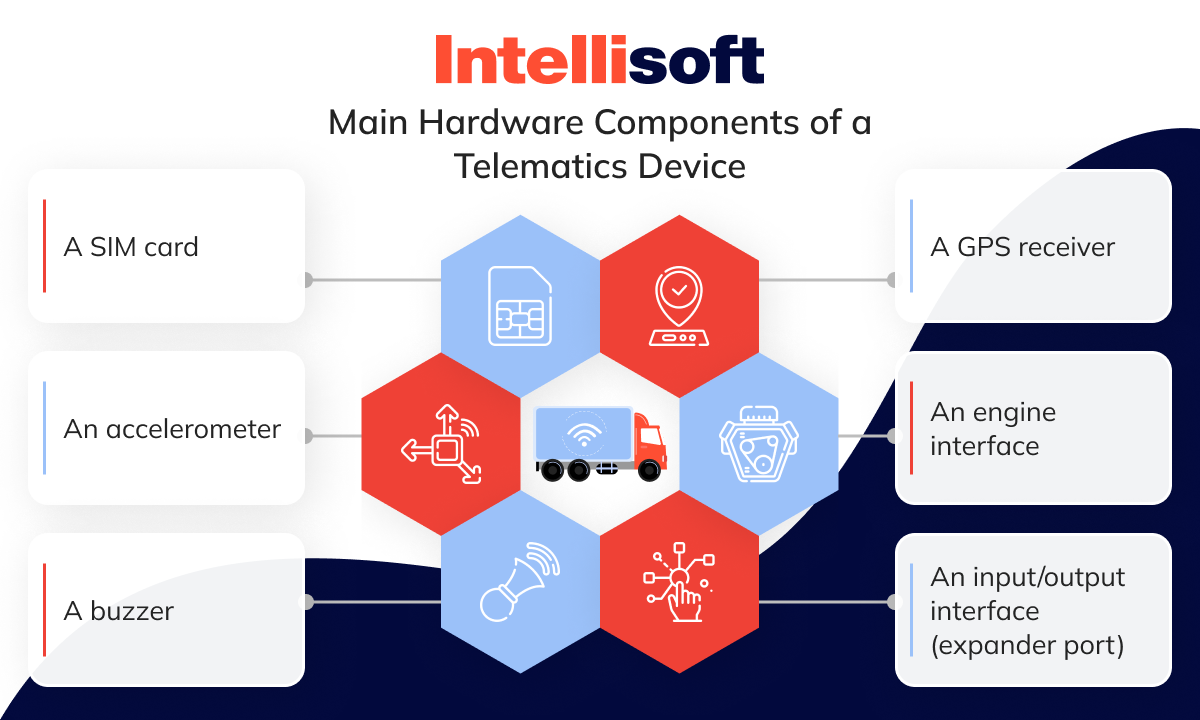
- A GPS receiver
- An engine interface
- An input/output interface (expander port)
- A SIM card
- An accelerometer
- A buzzer
In addition to the hardware, the algorithm for GPS logging is another key element, as it plays a big role in determining the accuracy and reliability of the data. After we learned the telematics system definition, let’s look how it works.
How Does Telematics Work in a Car?
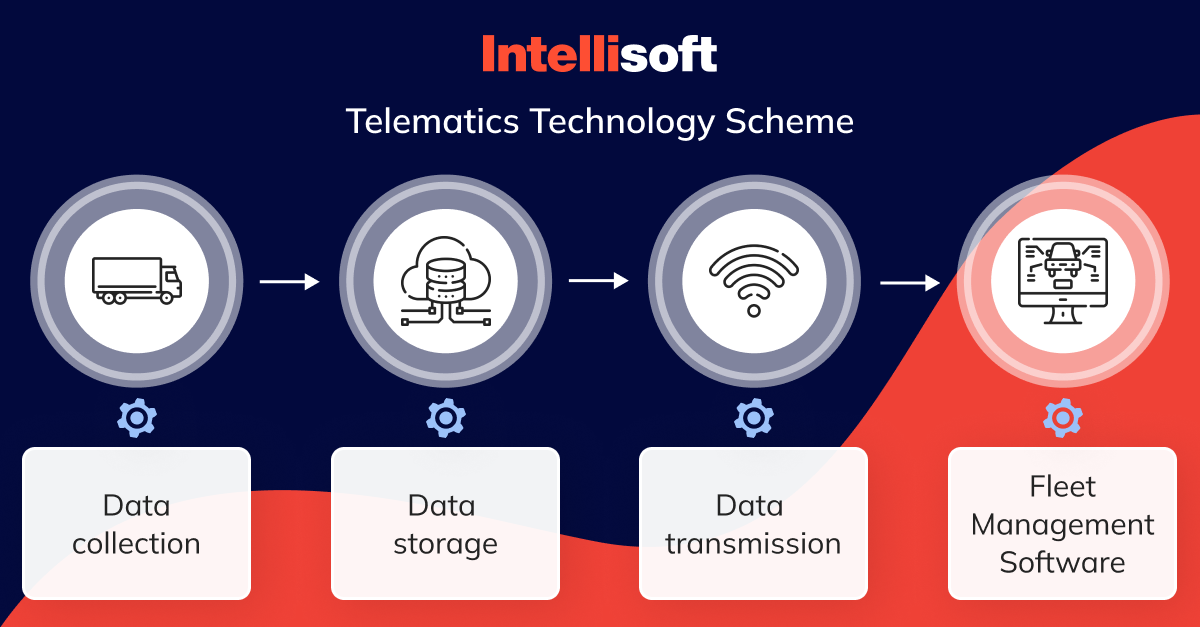
Telematics technology involves handling data through a four-step process: gathering, storing, transmitting, and managing it with fleet management software.
Data Collection
A telematics system gathers information from various sources, such as sensors, engine diagnostics, and GPS, and then shares it with fleet operators, helping them make data-driven decisions.
The sensors monitor driving behaviors, such as risky maneuvers, sudden braking, or rapid acceleration. They also track conditions inside the vehicle, like the cab’s temperature or whether a door has been opened. Engine diagnostics, on the other hand, provide insights into fuel efficiency and the vehicle’s overall maintenance status. The system continuously runs real-time diagnostics, offering valuable information for better fleet maintenance and management.
GPS data shows the vehicle’s location and movement, which is crucial for managing the fleet. It also tracks speed and other movement details, all visible through the GPS technology, aiding in more efficient oversight of the fleet’s performance.
Data Storage
Data from sensors, engine diagnostics, and GPS trackers is transmitted to the vehicle’s telematics device. It is stored briefly in the receiver before being forwarded.
Data Transmission
The data collected from the vehicle’s black box is securely transmitted to centralized servers through various network options, such as GPRS, satellite communication, or cellular networks like 4G. Once received, the server processes this data to prepare it for further use. Specifically, the information is analyzed, categorized, and optimized so fleet management software can easily access and utilize it for operational needs.
Fleet Management Software
The optimized data is sent from the centralized server to fleet management software, where it’s transformed into a user-friendly interface. This allows fleet operators to interpret the information easily. The software is designed to be flexible, enabling it to carry out different functions based on the specific needs of the team or company.
What Is Fleet Telematics?
These days, telematics software is essential for effective fleet management. Telematics software helps fleet managers answer questions such as:
- How can we reduce fuel consumption?
- Are my drivers speeding?
- Would switching to electric vehicles be cost-effective for our business?
- Is idling costing my fleet time and money?
Fleets of all sizes and business types use telematics software, from small businesses to large corporations, not-for-profit organizations, and government agencies. Allied Market Research values the global vehicle telematics system market at $50.4 billion in 2018 and estimates it will reach $320 billion by 2026.
Industries using fleet telematics vehicle system :
- Courier and delivery companies
- Field sales and other services such as HVAC, plumbing, etc.
- Towing companies
- Trucking and transportation logistics
- Construction businesses
- Food and beverage companies
- Transit fleets, such as motor coach, public transit, taxi and paratransit
- Oil, gas, and mining industries
- Utilities
- Police, first responders, and other public agencies
- Landscaping
- Waste management fleets
- Car rental and leasing companies
What Kind of Data Is Processed with Telematic Systems?
Telematics systems gather and analyze various data to track vehicle performance, monitor driver behavior, and offer valuable insights for different applications. The typical types of data processed include:

Vehicle data
The following aspects are covered here:
- Speed. Provides both real-time and average speed metrics, offering insight into current driving conditions and performance.
- Fuel consumption. Keeps track of fuel efficiency and usage trends to help monitor driving habits and optimize fuel usage.
- Engine performance. Delivers detailed reports on engine health, including diagnostics and alerts for issues like a check engine light.
- Odometer readings. Tracks total mileage, which is crucial for scheduling regular maintenance or managing a vehicle fleet.
- Tire pressure. Monitors data from the tire pressure system to ensure safe driving and prevent potential issues from underinflated tires.
- Battery voltage. Displays the battery’s current charge and health, which is particularly important for electric vehicles.
GPS and location data
This includes the following information:
- Live location. Shows the vehicle’s current GPS position in real-time.
- Route history. Keeps a record of routes traveled, including stops, detours, and traffic conditions.
- Geofencing alerts. Notifies when a vehicle crosses into or leaves designated geographic zones.
Driver behavior
This data tracks key aspects of driving behavior:
- Acceleration and braking. Highlights patterns of harsh braking, rapid acceleration, or speeding.
- Cornering. Records instances of aggressive turning and sharp cornering.
- Idle time. Measures how long the vehicle remains stationary with the engine running.
- Seat belt usage. Monitors whether seat belts are being worn.
Environmental and surrounding data
This information combines real-time data to improve driving decisions:
- Weather conditions. Incorporates weather data to provide better insights into current driving conditions.
- Traffic conditions. Offers real-time traffic updates to help optimize routes and estimate travel times.
Maintenance and diagnostics
This data covers various alerts to keep the vehicle in optimal condition:
- Vehicle health. Provides alerts for potential mechanical or electrical issues, such as engine diagnostics or transmission problems.
- Service reminders. Sends notifications for scheduled maintenance tasks such as oil changes or tire rotations.
Communication data
This overview highlights key communication technologies that enhance vehicle safety and interaction with infrastructure:
- Vehicle-to-vehicle (V2V). Enables data sharing with nearby vehicles, improving safety by alerting drivers to potential hazards.
- Vehicle-to-infrastructure (V2I). Facilitates communication with road infrastructure, such as traffic lights and toll booths.
Insurance and compliance data
This data highlights how driving habits and compliance are monitored for insurance and regulatory purposes:
- Usage-based insurance (UBI). Shares driving data with insurance providers to adjust premiums according to individual driving habits.
- Compliance data. Tracks data for regulatory requirements, such as hours of service for commercial drivers.
Benefits of Telematics Use in Fleet Management
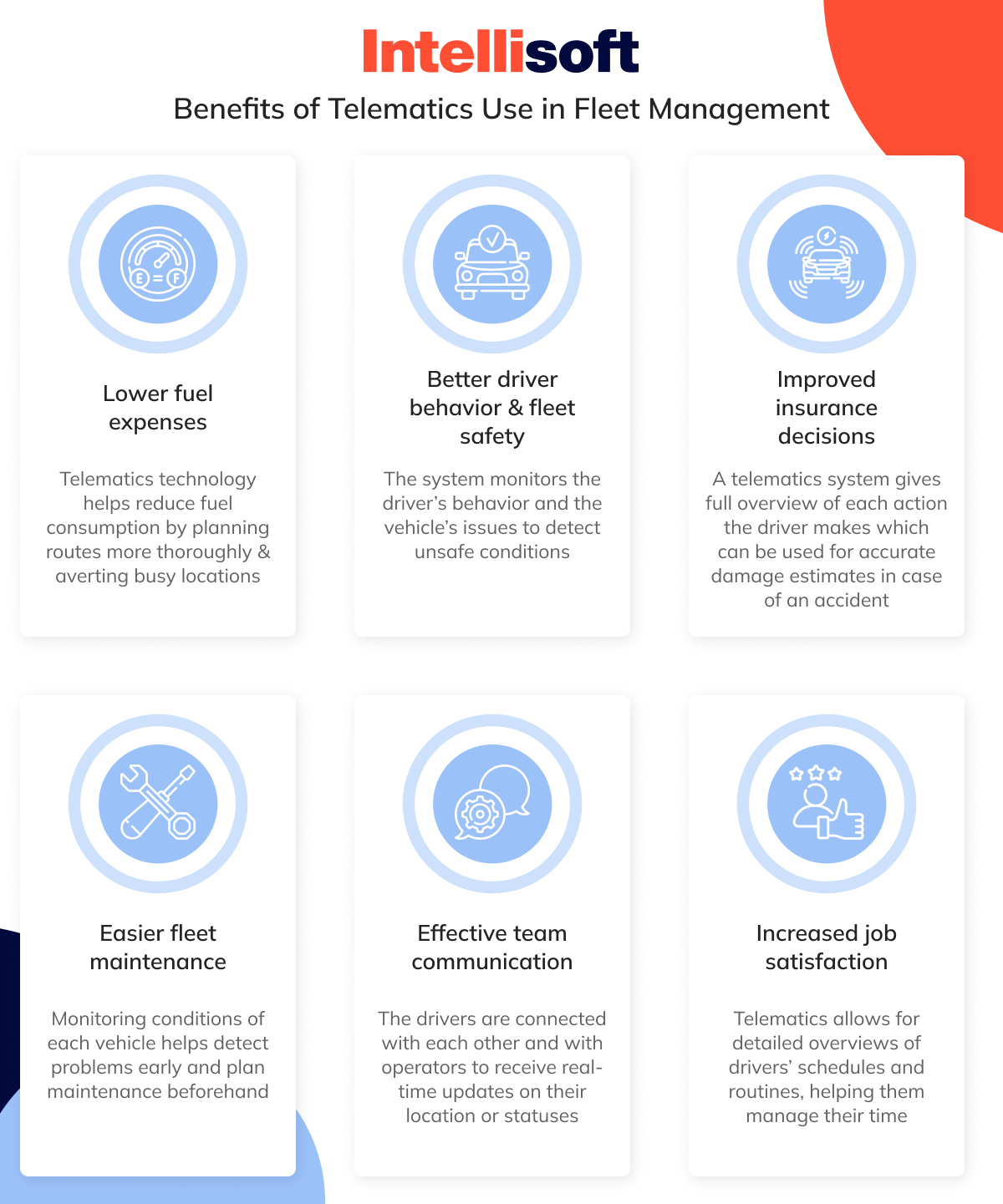
Here are some benefits that fleet telematics system qualities bring to fleet management with real-life use cases.
Lower Fuel Expenses
Managing fuel costs is a key challenge in vehicle and fleet operations, especially for industry-focused businesses. Thankfully, telematics technology reduces fuel consumption by monitoring various performance metrics and adjusting accordingly. For instance, better route planning, managing traffic bottlenecks and keeping track of vehicle health all help reduce fuel use and ultimately save money.
A practical example: Look how aggressive driving or excessive idling can raise fuel expenses. With telematics, companies can gain insights into these behaviors and develop targeted training programs encouraging drivers to adopt more fuel-efficient habits.
Better Driver Behavior and Fleet Safety
Companies managing fleet operations require robust and secure safety systems to ensure efficient fleet management. These technologies enable real-time monitoring of driver behavior and vehicle conditions, helping to identify and address any potential safety risks quickly. When unsafe conditions are detected, they can be swiftly managed. Furthermore, emergency responders can be dispatched to the exact location in an accident through system notifications.
A practical example: Telematics data can be used to generate detailed reports on driver behavior, helping to pinpoint and correct unsafe driving practices, which are often a leading cause of accidents.
Improved Insurance Decisions
With a telematics system, you can gather precise data on vehicle use. It essentially provides a detailed breakdown of every driver’s action, such as braking and changes in speed. This information can be leveraged for in-depth driving analysis and to produce more accurate damage assessments following an accident.
A practical example: Euristiq helped develop an accident monitoring platform that tracks driver behavior. This data is then used by an insurance company with fleets to fine-tune their vehicle insurance packages, optimizing them based on real-world usage.
Easier Fleet Maintenance
The telematics fleet management system monitors each vehicle’s condition closely, sending timely alerts whenever something seems off. This proactive approach allows for early detection of potential issues, ensuring they are addressed before disrupting established workflows or operational processes. Additionally, the system’s diagnostics assist in scheduling maintenance, helping maintain consistent vehicle performance and extending lifespan.
A practical example: By utilizing telematics, companies can reduce long-term equipment wear and tear, strategically plan the upkeep of high-wear components like brakes and tires, and even benchmark their fleet’s health against similar equipment other businesses use.
Effective Team Communication
Connecting drivers and logistics operators was once a complex, manual process, but telematics technology has streamlined and automated this task. With less need for human intervention, both drivers and operators now effortlessly receive real-time updates on their locations and statuses.
A practical example: Geotab is the global telematics provider that offers fleet operators real-time data on drivers, allowing communication through in-vehicle alerts. These alerts can remind drivers to fasten their seatbelts or reduce speed, enhancing safety and efficiency on the road.
Increased Job Satisfaction
Telematics offers a comprehensive look at drivers’ schedules and routines, allowing them to track how much time remains on their shift and plan their workday more efficiently, including any necessary training. Meanwhile, operators can access this information, enabling them to coordinate operations more smoothly. This level of transparency enhances both convenience and predictability, boosting job satisfaction for drivers and operators.
A practical example: A telematics platform can help ensure driver safety on the road by monitoring compliance with rest time regulations and sending alerts when a break is due. This helps prevent fines and violations and leads to happier, more content drivers.
Related articles:
- App for Route Planning: Finding the Ultimate Solution
- Security Logistics: The Guide to Supply Chain Security Management
- Demand Forecasting in a Supply Chain: Unlock Your Potential
- Transport Management Software: Benefits and Main Features
- Real Time GPS Vehicle Tracking Software Development
When to Develop a Custom Telematic System for Fleet Management vs. Using a SaaS Solution
When deciding between building a custom telematics system for fleet management or opting for a SaaS (Software-as-a-Service) solution, several factors come into play—your business needs, operational scale, budget constraints, and the level of feature complexity you require. Each approach offers its advantages and disadvantages, and understanding these can help you choose the best fit for your specific use case.
Custom Telematic System
Choosing a custom telematics system is ideal when your fleet has specific operational needs that generic solutions can’t meet. It’s also a great fit for fleets expected to grow significantly, as these systems can be tailored to scale alongside your business. If your company relies on older or proprietary software, a custom system ensures smooth integration without losing critical data or functionality.
First, look at the benefits of a custom fleet telematics system for sale:
- Full control over interface and backend processes
- Smooth integration with existing ERP or accounting systems
- Complete data ownership for regulatory compliance
- Adapts easily as your fleet grows or changes
However, there are drawbacks to consider:
- You need to make significant investments
- Development can take months or years to implement
- Such a system requires continuous support and updates
- Custom nature adds management challenges to fleet operations
Custom telematic systems are especially suited for large fleets with specialized needs. For businesses operating hundreds of vehicles, these systems provide advanced features such as custom routing and AI-powered analytics, integrating seamlessly with custom-built logistics platforms. They are also essential in industries with strict regulatory constraints, such as healthcare, defense, or hazardous materials transport, where full control over data and reporting is required.
SaaS Telematic Solutions
A SaaS telematics solution is ideal for quickly deploying a telematics based fleet management system, often operational within days. It suits small to medium fleets, offering essential features without custom development. SaaS is cost-effective, with a subscription model and user-friendly interfaces that require minimal IT resources. Providers also handle updates and bug fixes, keeping the system up-to-date with little effort.
Let’s look at the advantages of SaaS telematic systems:
- Low initial cost with subscription-based pricing
- Quick setup thanks to pre-built infrastructure
- Providers manage security, maintenance, and updates
- Scalable for small to medium-sized fleets
However, there are some drawbacks:
- Limited customization options
- Recurring fees can increase as the fleet grows
- Data stored on provider’s servers may raise privacy concerns
- Lacks advanced analytics or custom reporting
- Reliance on provider for updates and support can reduce flexibility
SaaS telematic systems are ideal for small to medium fleets, startups, and businesses needing standard features like tracking and fuel management. They’re cost-effective for logistics companies and fleet leasing services, offering basic tracking, route optimization, and vehicle monitoring without advanced customization.
Comparison at a Glance
Let’s compare these two types of telematic systems in the table below.
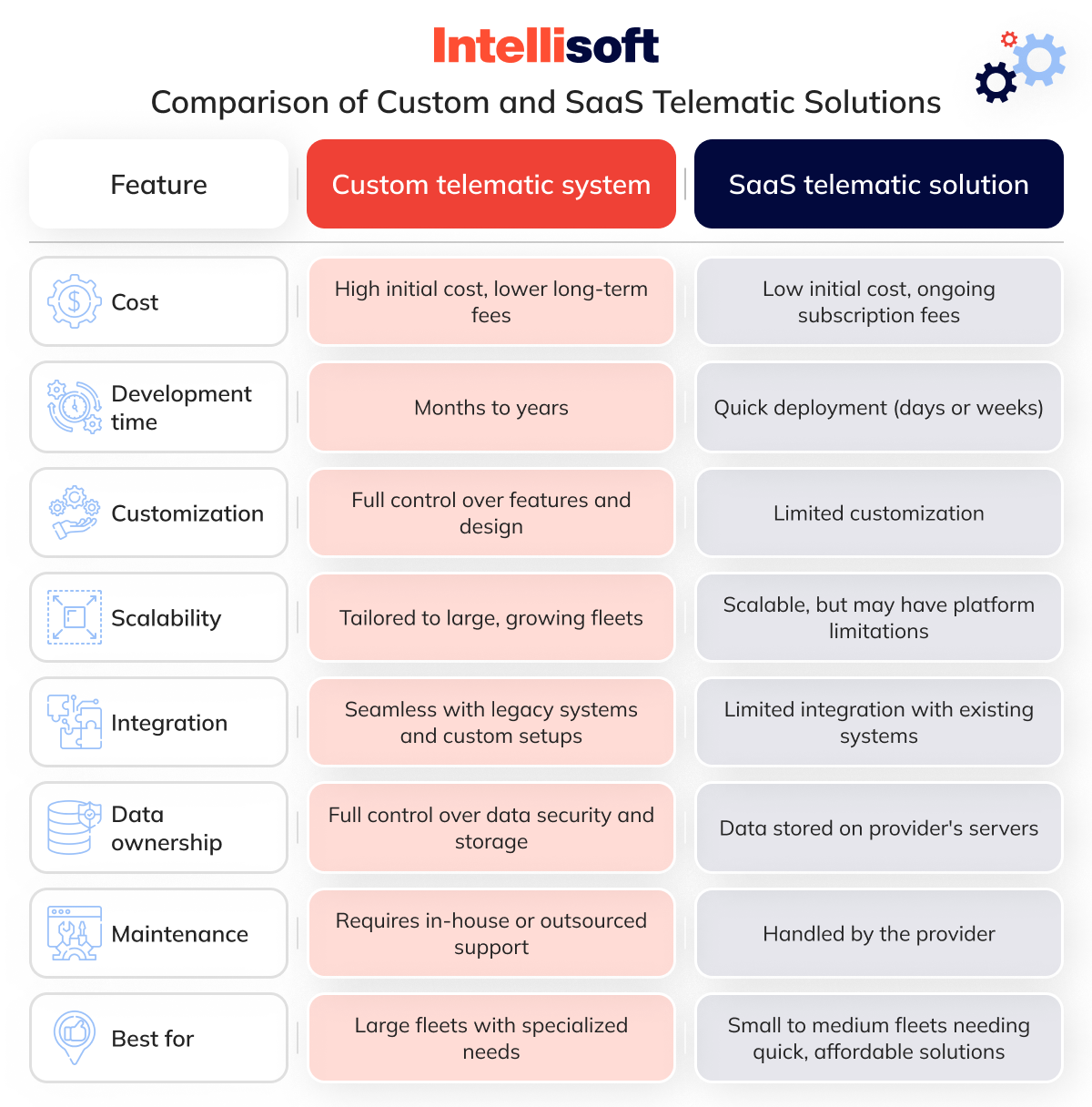
How to Develop a Telematic System for Your Fleet: A Step-by-Step Guide
Efficient fleet management goes beyond just keeping tabs on your vehicles. A telematic system can give you real-time data on your fleet’s performance, how your drivers behave on the road, and overall operational efficiency. Here’s a step-by-step guide to help you create an automotive-telematics-system tailored to your fleet’s needs.
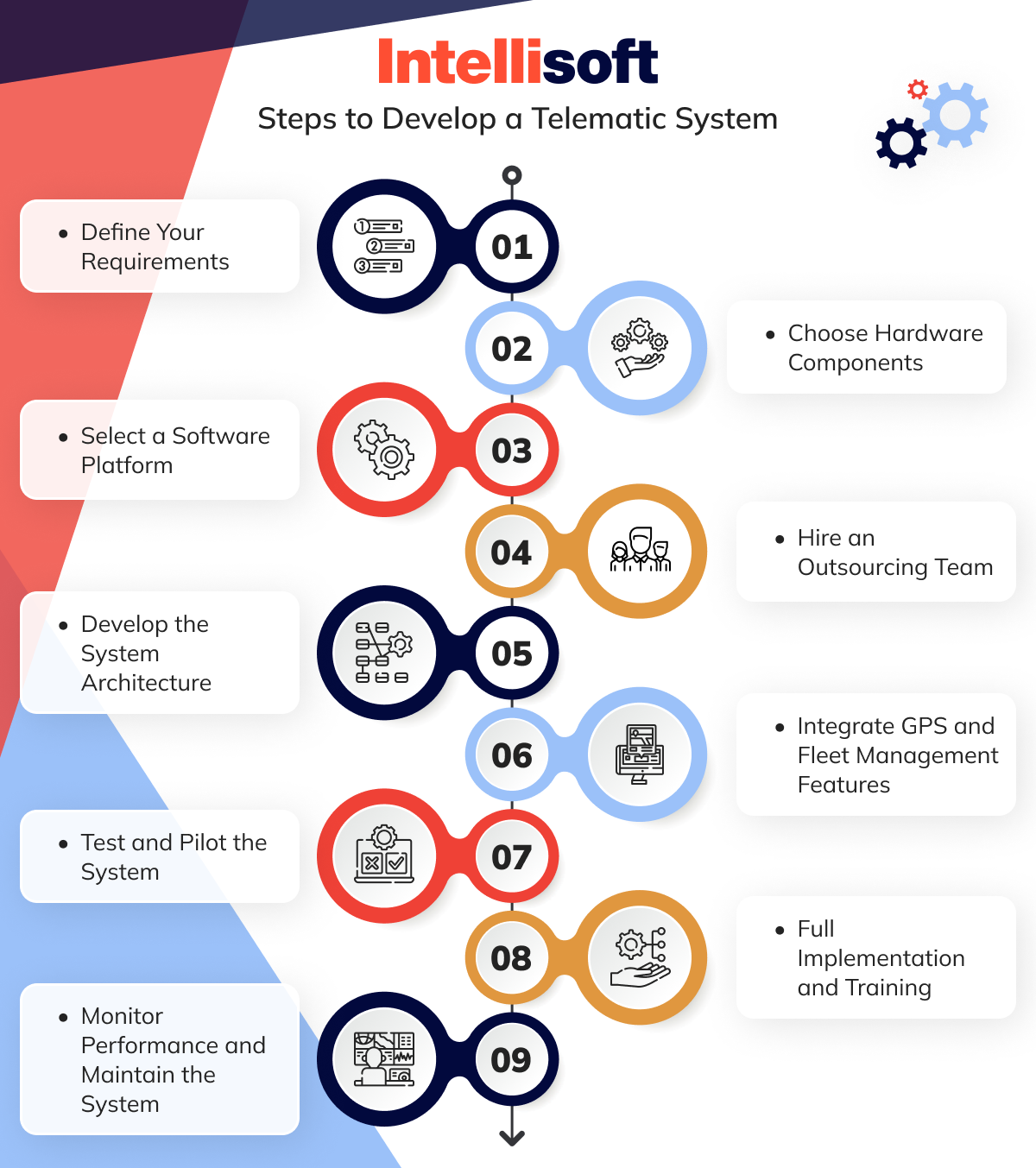
Step 1. Define Your Requirements
Before selecting a telematics system, it’s essential to pinpoint exactly what you need. Are you focused on real-time GPS tracking, keeping tabs on fuel consumption, or analyzing driver behavior? Identifying these specific goals will guide you in choosing a solution that aligns with your fleet’s requirements. Some crucial factors to consider include:
- Monitoring vehicles and optimizing routes
- Evaluating driver safety and behavior
- Receiving alerts for predictive maintenance
- Tracking fuel consumption to reduce costs
Step 2. Choose Hardware Components
You’ll need in-vehicle hardware to gather and transmit data to set up a telematics system. This typically involves:
- GPS units that track the vehicle’s location and routes
- Onboard diagnostics (OBD-II) devices to keep an eye on engine performance and other key diagnostics
- Sensors that monitor fuel levels, tire pressure, and environmental factors
Step 3. Select a Software Platform
The software serves as the central hub of a telematics system, taking data from the hardware and transforming it into insights through a user-friendly interface. When choosing a platform, look for features such as:
- A dashboard for fleet managers to easily track both vehicle and driver performance
- Data analytics tools that generate reports and provide actionable insights.
- Seamless integration with other enterprise systems, like maintenance management or accounting software
- Scalability and robust security measures to safeguard sensitive information
Step 4. Hire an Outsourcing Team
Building a fleet telematics system from the ground up demands high technical expertise. By outsourcing to a team such as IntelliSoft, you gain access to skilled software developers, data engineers, and telematics experts—without the expense of maintaining an in-house team. Here’s why outsourcing makes sense:
- IntelliSoft brings extensive experience in creating sophisticated telematics and fleet management solutions.
- Outsourcing helps you sidestep the significant costs of recruiting, training, and retaining an internal development team.
- A dedicated outsourcing team can significantly reduce development time, helping you achieve a quicker return on investment.
- IntelliSoft also provides continuous technical support and maintenance, ensuring your system stays up and running smoothly.
Step 5. Develop the System Architecture
Once your team is in place, design the video telematics system architecture. This includes:
- Define the data flow from vehicles to the cloud and your platform
- Build a backend capable of processing real-time data from multiple vehicles
- Create an intuitive frontend for fleet managers to access reports and insights
- Implement security protocols to encrypt and securely store data in compliance with regulations
Step 6. Integrate GPS and Fleet Management Features
Once the system has been designed, you must incorporate the essential GPS tracking and fleet management features. This includes:
- Enabling real-time location tracking.
- Configuring geofencing capabilities.
- Integrating tools for fuel consumption and maintenance monitoring
- Adding driver behavior analysis to track speeding, harsh braking, and other metrics
Step 7. Test and Pilot the System
Before fully implementing the telematics tracking system across your entire fleet, conducting a pilot test is crucial. This process allows you to spot bugs, identify issues, and refine the system. During this pilot phase, you should:
- Roll out the system to a small group of vehicles first
- Monitor the data closely to ensure it’s both accurate and timely
- Use feedback from fleet managers and drivers to make any necessary adjustments
Step 8. Full Implementation and Training
Following the pilot’s success, deploy the telematics fleet management system. Ensure fleet managers and drivers receive proper training to utilize the system efficiently. Offer user guides and organize hands-on workshops to help your team familiarize themselves with the full scope of the system’s features.
Step 9. Monitor Performance and Maintain the System
Consistent monitoring becomes essential once the system fully runs to keep it working smoothly. Make sure to use the analytics tools available in your telematics platform to:
- Track vehicle performance and health
- Fine-tune routes for better fuel efficiency
- Verify that drivers are adhering to safety protocols
Collaborate with your outsourcing team to keep the system updated regularly. This can include adding new features or tweaking the setup as your fleet’s needs grow and change.
How Much Will a Custom Telematic System Development Cost?
The cost of building a custom telematics embedded system can vary quite a bit depending on several factors. They include the complexity of the project, the size of the team, the features you want to include, the tech stack you’re using, and even the location of the team you’re working with. To give a more accurate estimate, here’s a closer look at what can influence the final price:
Key Cost Drivers
When planning the development of your truck telematics system, several factors play a pivotal role in shaping the overall cost. Here’s a breakdown of key considerations:
Development team
Your development team’s size and expertise level can greatly influence expenses. Rates for outsourcing can vary depending on location, with some general averages being:
- North America (USA, Canada): $100–$200 per hour
- Western Europe (UK, Germany, France): $80–$150 per hour
- Eastern Europe (Ukraine, Poland): $40–$70 per hour
- India and Southeast Asia: $20–$50 per hour
Project complexity
Another significant cost factor is the complexity of the project. A basic system with minimal features will cost less, while one incorporating advanced functionality—such as analytics, artificial intelligence, or machine learning—will increase the price. Additionally, the level of integration with other platforms and real-time data needs can drive up costs.
Development time
The time it takes to complete development is typically measured in man-hours or person-months. A straightforward telematics system might take 6 to 12 months to build, whereas more sophisticated solutions could require 12 to 24 months or longer.
Breakdown of Costs by System Complexity
Let’s look at the rough estimates based on the complexity of the telematics system in car.
Basic telematics system
A standard system typically encompasses GPS tracking, route optimization, fuel consumption monitoring, and basic analytics for driver behavior. This project will take 6 to 9 months and require 6 to 8 developers.
The cost estimate is as follows:
- North America: $300,000 to $600,000
- Western Europe: $250,000 to $500,000
- Eastern Europe: $150,000 to $300,000
- Asia/India: $80,000 to $200,000
Mid-range telematics system
This system offers various advanced features, including real-time analytics, geofencing capabilities, vehicle health tracking, predictive maintenance, and enhanced driver performance analytics. This project will take 9 to 12 months and will require 10 to 12 developers.
The cost estimate is as follows:
- North America: $600,000 to $1.2 million
- Western Europe: $500,000 to $1 million
- Eastern Europe: $300,000 to $600,000
- Asia/India: $200,000 to $400,000
Complex/enterprise-grade telematics system
A sophisticated system often encompasses a variety of advanced technologies, including AI-powered analytics, detailed reporting tools, and seamless ERP system integration. It processes data in real time and is accessible through mobile applications. It also features vehicle-to-vehicle (V2V) and vehicle-to-infrastructure (V2I) communication capabilities. Custom AI functions like predicting driver behavior and optimizing fuel efficiency are typically incorporated.
The development of such a system usually takes 12 to 24 months and requires a team of 15 to 20 or more developers.
The cost can vary significantly depending on the region:
- North America: $1,200,000 – $3,000,000+
- Western Europe: $1,000,000 – $2,500,000+
- Eastern Europe: $600,000 – $1,500,000+
- Asia/India: $300,000 – $800,000+
Other Contributing Costs
However, the development process would require some additional costs.
Hardware costs
Regarding hardware, there are several factors to keep in mind. You’ll need in-vehicle devices like OBD-II tools, GPS trackers, fuel sensors, and tire pressure monitors. Depending on the level of sophistication you opt for, these prices can vary significantly, ranging anywhere from $50 to $300 per vehicle. Additionally, if you’re managing a large fleet, the costs don’t stop at just purchasing the devices—installation and ongoing maintenance will also need to be factored into your budget.
Cloud infrastructure and data storage
Cloud hosting services, such as AWS, Azure, or Google Cloud, will play a crucial role in storing and processing the data generated by your system. The actual cost will depend largely on how much data you’re dealing with—real-time data, for example, requires more bandwidth and processing power. Furthermore, recurring subscription fees for cloud infrastructure, API access, and data storage can range anywhere from $500 to upwards of $5,000 per month, depending on the scale of your operations.
Licensing and compliance
Software licensing fees could become an ongoing expense if you’re utilizing third-party software, such as mapping APIs. Moreover, compliance with data protection laws (like GDPR in Europe or CCPA in California) is necessary in many regions. Ensuring that your telematics vehicle tracking system meets these regulations might involve additional costs, such as legal consultations or implementing robust data encryption measures.
Support and maintenance
Finally, remember to budget for the system’s ongoing support and maintenance. After the initial setup and development, you’ll need to cover costs for updates, bug fixes, and potentially adding new features over time. These expenses typically amount to 15-25% of the original development cost annually.
Summary of Estimated Costs
Now, let’s put all the estimates together in the table below.
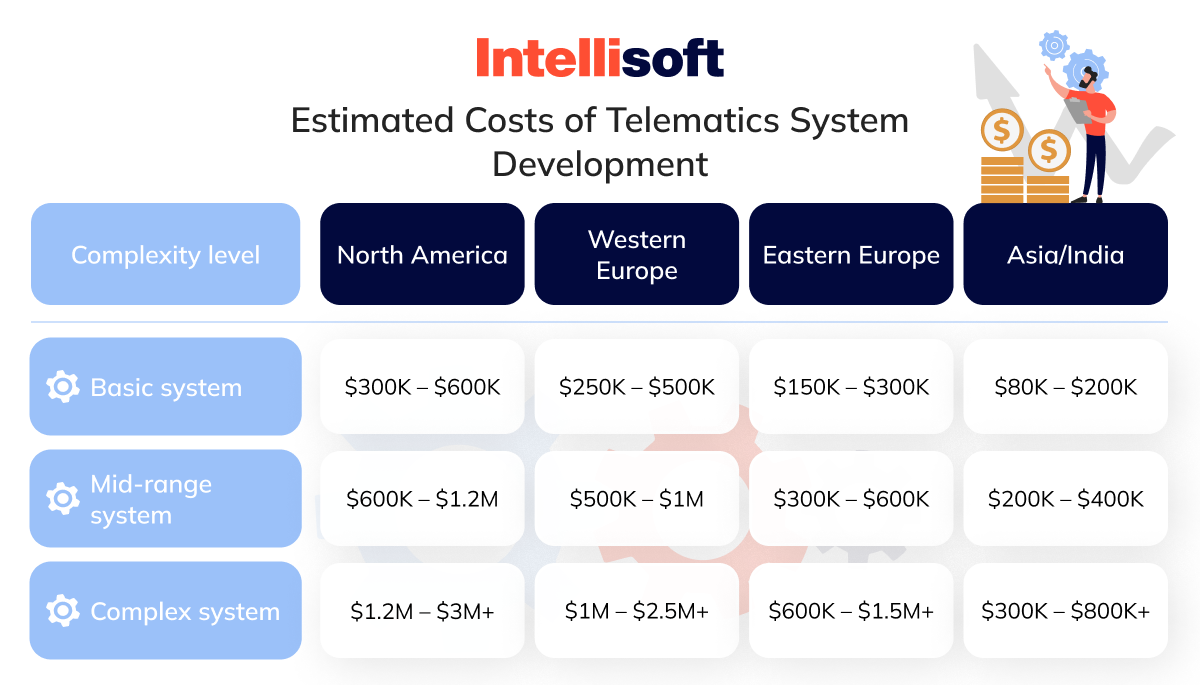
How Many Developers Do I Need to Develop a Telematics System?
The number of developers required for a telematics system will vary depending on the project’s complexity, scale, and the timeline you’re working with. To give you a general idea, the estimate typically involves key roles such as:
Core Development Roles
First, we will review core roles in a development team. Here they are:
Backend developer (1-2 developers)
- Responsibilities. Responsible for constructing the server-side architecture, developing APIs, and managing the flow of communication between the hardware (like devices in vehicles) and the software components (such as dashboards and reports).
- Skillset. Strong expertise in handling substantial volumes of real-time data, proficient database management, cloud services, and API creation.
Frontend developer (1-2 developers)
- Responsibilities. Focus on creating a user-friendly interface (UI) that allows fleet managers to engage with the system, including developing dashboards, reports, and vehicle tracking screens.
- Skillset. Proficiency in web development frameworks like React, Angular, or Vue.js, with mobile app development skills as a plus.
Embedded systems developer (1-2 developers)
- Responsibilities. Working directly with hardware, these developers integrate GPS, sensors, and vehicle diagnostic tools (like OBD-II) while managing communication between the hardware and backend systems.
- Skillset. Expertise in embedded systems, IoT communication protocols, and familiarity with automotive standards.
Data engineer (1-2 developers)
- Responsibilities. Design and fine-tune the data pipeline to ensure data from vehicles is efficiently processed, stored, and accessible for real-time analytics and reporting.
- Skillset. Deep knowledge of cloud computing, data warehousing, and big data technologies such as Kafka, Hadoop, or Spark.
Mobile app developer (optional, 1 developer)
- Responsibilities. If the system includes a mobile app for fleet managers or drivers, this developer would handle telematics system design and integration with backend APIs.
- Skillset. Proficiency in Android/iOS app development and API integration.
Additional Supporting Roles
Besides, your team may require the following roles to make a complete vehicle telematics system solution.
UX/UI designer (1 designer)
- Responsibilities. Crafting an intuitive and user-friendly interface tailored to fleet managers and drivers, ensuring the system is easy to navigate.
- Skillset. Deep understanding of design principles, with hands-on experience collaborating with development teams to bring interfaces to life.
DevOps engineer (1 developer)
- Responsibilities. Overseeing cloud infrastructure, system deployment, ensuring uptime, and automating essential tasks like monitoring, updates, and backups.
- Skillset. Expertise in cloud platforms (AWS, Azure, or Google Cloud), CI/CD pipelines, and containerization technologies like Docker and Kubernetes.
QA/test engineer (1-2 testers)
- Responsibilities. Conducting thorough testing for bugs and performance issues, ensuring the automotive telematics system adheres to security and functionality standards. Given the high data volume in telematics systems, performance, and stress testing are especially crucial.
- Skillset. Proficiency in automation and load testing, with experience in handling telematics or other data-intensive systems.
Project manager (1 manager)
- Responsibilities. Acting as the coordinator among team members, managing timelines, project scope, and keeping everything on track.
- Skillset. Proven experience in overseeing software development projects, particularly those involving IoT or telematics technology.
Estimated Team Size Breakdown
For a small-scale telematics system with core tracking and route optimization functionalities, you can start with a lean team of around 6 to 8 developers. This team might include:
- 1 backend developer
- 1 frontend developer
- 1 embedded systems developer
- 1 data engineer
- 1 UX/UI designer
- 1 QA/test engineer
For a medium-scale system, which incorporates more advanced features such as analytics, predictive maintenance, and real-time monitoring, you’ll likely need a larger team consisting of 10 to 12 developers. The roles could be distributed as follows:
- 2 backend developers
- 2 frontend developers
- 2 embedded systems developers
- 2 data engineers
- 1 UX/UI designer
- 1 QA engineer
- 1 DevOps engineer
- 1 Project manager
Regarding a large-scale system, handling hundreds of vehicles, custom integrations, AI-driven analytics, and mobile applications, the team size would typically increase to 15 or more developers. Here’s a possible breakdown:
- 2-3 backend developers
- 2-3 frontend developers
- 2 embedded systems developers
- 2-3 data engineers
- 1 mobile app developer
- 1 UX/UI designer
- 2 QA engineers
- 1 DevOps engineer
- 1 Project manager
Conclusion
Building a custom telematics GPS system can revolutionize fleet management by delivering real-time insights into vehicle performance, driver behavior, and overall operational efficiency. Whether you’re looking for a simple GPS tracking setup or a more sophisticated system with predictive maintenance features and AI-powered analytics, opting for a custom solution lets you control its features and scalability.
What is telematics and how does it work? Learning this requires substantial time, resources, and specialized knowledge. This is where partnering with a dependable outsourcing firm can make a significant difference. IntelliSoft, a well-established software outsourcing provider, has experience creating bespoke telematics solutions tailored to your fleet’s needs. Our expertise in IoT, data analytics, and fleet management technologies ensures we can deliver a robust, scalable system aligned with your business objectives—without an internal development team’s high costs and management challenges.
By tapping into IntelliSoft’s deep expertise in logistics, you can build a telematics system that enhances your fleet’s performance and drives greater operational efficiency and sustainable growth. Whether you’re managing a handful of vehicles or a large-scale fleet, we can help you develop a solution that addresses your unique operational challenges. Contact us today to discuss your needs and requirements!






